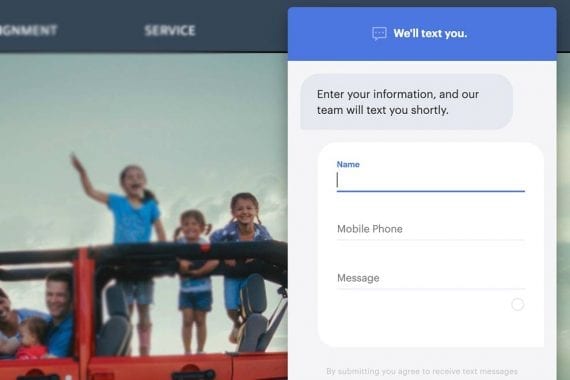Text messaging can help ecommerce marketers engage and retain customers, but it is not a replacement for email communication or mobile apps.
In 2021, roughly 280 million Americans will own a smartphone out of a total population of 328.2 million, according to Statista. Smartphones are ubiquitous, in other words.
Many smartphone owners are seemingly addicted to their devices, looking at them between 80 and 100 times a day, depending on which survey you read.
Text messaging — specifically, short message service (SMS) communication — is among the most popular smartphone applications. An often-quoted Gartner report from 2016, for example, found that SMS had an open rate of about 98 percent. And several other surveys estimate that many smartphone users will read a text message within five minutes of receiving it.

Most American adults use a smartphone and check it regularly. Photo: Jayana Rashintha.
It is clear that folks like text messaging. Arri Bagah, a conversational marketing practitioner and the founder of Conversmart, a marketing firm, claims that something like 80 percent of ecommerce customers wants to receive SMS messages.
If, however, commerce businesses abuse SMS, it is likely that customers will start unsubscribing, blocking, and ignoring those messages.
So how does an ecommerce marketer strike a balance and use SMS communications in a way that is both customer-pleasing and profit-improving? Here are seven tips to help.
7 SMS Tips for Ecommerce
1. Start with transactional messages. Perhaps the most obvious use of SMS for ecommerce is with transactional messages. Many businesses are already using text to notify shoppers when an order is received, shipped, and delivered.
These sorts of messages are easy and informative.
During the checkout process, ask shoppers if they want SMS notifications. Then add them to your texting list accordingly.
2. Get a net promoter score. Use your company’s transactional text messages as a foundation to gain usable marketing information, such as obtaining a net promoter score from new customers.
An NPS is an excellent key performance indicator for monitoring the growth potential of an ecommerce company.
Many businesses regularly employ NPS with email messages. While text messages are not a direct replacement for email, there are some things that SMS can do better. Soliciting NPS responses is one of those things.
Merchants can automate the process, sending a one-question NPS survey via SMS shortly after a customer’s order has been delivered.
The survey result could trigger other actions, such as notifying a customer service agent or sending a follow-up question.
3. Use text for chat. Monitor your web analytics for the percentage of visitors from a mobile device. That percentage could be 50 percent or higher depending on your products and target audience.
With this in mind, some retailers and B2B sellers are using SMS instead of web-based chat.
Both experiences are similar for the user. A chat icon is shown somewhere on the page, often in the lower right-hand corner. When she opens the chat window, the shopper could (for text messaging) provide her name and a text number instead of immediately typing in a question.
Podium and SimpleTexting are examples of text-messaging-chat providers.

SMS chat is similar to web chat. There is a familiar icon, for example, but the conversation is quickly moved to text messaging rather than chat.
It is worth mentioning that SMS chat can be used in a few ways. Some commerce companies show a web-chat service to visitors on a desktop computer and SMS chat to folks on a mobile device. It is even possible to offer both text- and web-chat and let visitors choose.
4. Ask for a review. SMS can be a good tool for generating reviews.
Here is a scenario. Imagine a shopper has been SMS chatting with a customer service representative at your company. The representative helped this shopper find a couple of products.
It would be perfectly reasonable to send an automated text message at the end of that conversation, requesting a customer-service review.
In the same way, if a shopper responded to an NPS survey with a high score, consider sending an automated text message, asking him to review the products he purchased.
5. Use RFM-based automation. The recency, frequency, and monetary value model can help ecommerce marketers identify and market to sets of customers based on their transactional history.
One of the ways to apply the RFM model is via triggered, automated marketing workflows.
For example, when a long-time customer has not purchased in a while — prompting that customer to move from a 555 to a 455 in a five-point RFM model — an automated workflow might assign a task to a customer service representative. That rep would look up the customer and send a personal re-engagement message via SMS.
6. Avoid excessive discounts. Some retailers and B2B sellers constantly put products on sale unnecessarily.
To be sure, discounting has its place in both retail and wholesale transactions, but it can be overdone. This is particularly true when a marketer is working with a relatively new promotional tool.
For example, I’ve seen a YouTube video where an enthusiastic marketer suggested putting a banner on an ecommerce checkout page that read, “Text [phrase] to [number] to receive jaw-dropping VIP deals right now.”
That idea makes little sense. It encourages an interruption of the checkout process and a “jaw-dropping” discount that is not likely required to close the sale.
7. SMS and the hammer. Finally, there is the old saying that when you are holding a hammer, everything looks like a nail.
SMS can be a helpful marketing tool, but it is not a direct replacement for email or a native mobile application.
Here is an example. Say an ecommerce company desired to share a few discounted items with customers. Which would be better: a text message or a push notification from a mobile application installed on the shopper’s phone? What if that company wanted to communicate links to five marketing articles. Should it use an email newsletter or SMS?
A text message probably makes the least sense in both cases. Instead of forcing it in every marketing situation, use text messaging only when it’s most effective.




